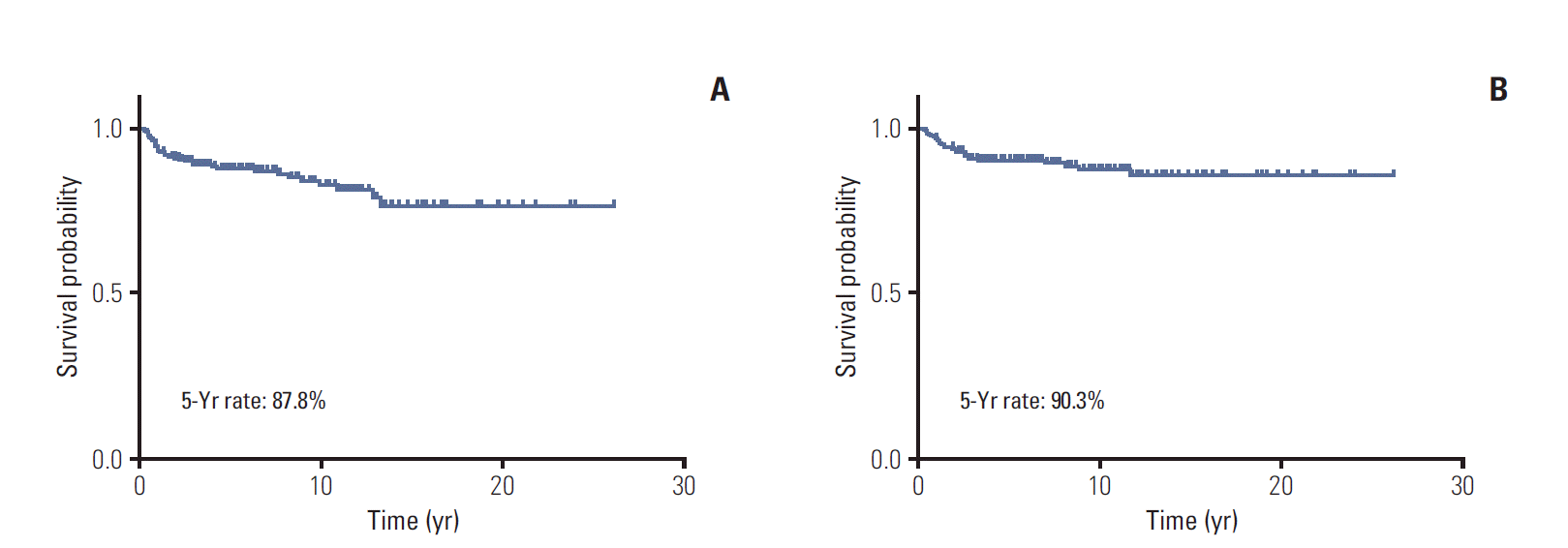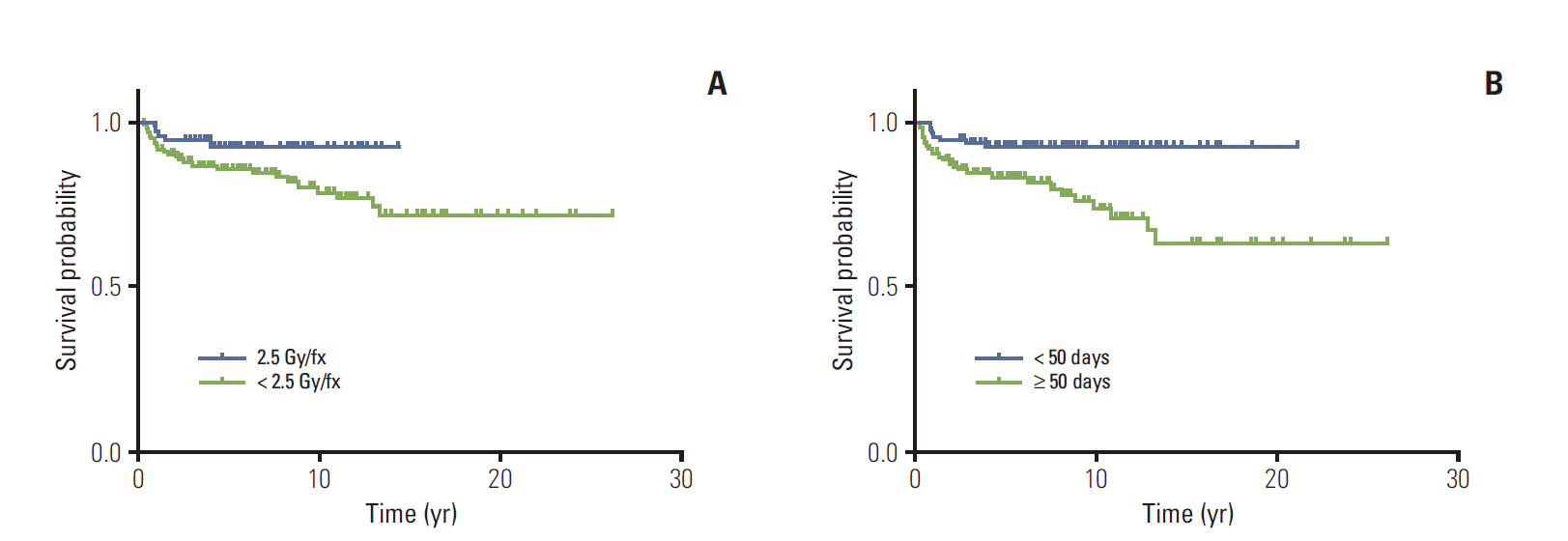1. Park CI, Shin KH, Park SW, Shin SS, Kim KH. Prognostic factors for local control and survival in T1-T2 glottic cancer. J Korean Cancer Assoc. 1997; 29:984–91.
2. American Society of Clinical Oncology, Pfister DG, Laurie SA, Weinstein GS, Mendenhall WM, Adelstein DJ, et al. American Society of Clinical Oncology clinical practice guideline for the use of larynx-preservation strategies in the treatment of laryngeal cancer. J Clin Oncol. 2006; 24:3693–704.

3. Taylor SM, Kerr P, Fung K, Aneeshkumar MK, Wilke D, Jiang Y, et al. Treatment of T1b glottic SCC: laser vs. radiation: a Canadian multicenter study. J Otolaryngol Head Neck Surg. 2013; 42:22.

4. Mendenhall WM, Mancuso AA, Amdur RJ, Werning JW. Early vocal cord carcinoma. In : Halperin EC, Wazer DE, Perez CA, Brady LW, editors. Perez and Brady’s principles and practice of radiation oncology. 6th ed. Philadelphia, PA: Lippincott Williams & Wilkins;2013. p. 856.
5. Rodel RM, Steiner W, Muller RM, Kron M, Matthias C. Endoscopic laser surgery of early glottic cancer: involvement of the anterior commissure. Head Neck. 2009; 31:583–92.

6. Kim SJ, Suh CO, Kim GE, Park CY. Radiation therapy of laryngeal cancer. J Korean Cancer Assoc. 1982; 14:3–12.
7. Chera BS, Amdur RJ, Morris CG, Kirwan JM, Mendenhall WM. T1N0 to T2N0 squamous cell carcinoma of the glottic larynx treated with definitive radiotherapy. Int J Radiat Oncol Biol Phys. 2010; 78:461–6.

8. Khan MK, Koyfman SA, Hunter GK, Reddy CA, Saxton JP. Definitive radiotherapy for early (T1-T2) glottic squamous cell carcinoma: a 20 year Cleveland Clinic experience. Radiat Oncol. 2012; 7:193.

9. Tong CC, Au KH, Ngan RK, Cheung FY, Chow SM, Fu YT, et al. Definitive radiotherapy for early stage glottic cancer by 6 MV photons. Head Neck Oncol. 2012; 4:23.

10. Kim TG, Ahn YC, Nam HR, Chung MK, Jeong HS, Son YI, et al. Definitive radiation therapy for early glottic cancer: experience of two fractionation schedules. Clin Exp Otorhinolaryngol. 2012; 5:94–100.

11. Mourad WF, Hu KS, Shourbaji RA, Woode R, Harrison LB. Long-term follow-up and pattern of failure for T1-T2 glottic cancer after definitive radiation therapy. Am J Clin Oncol. 2013; 36:580–3.

12. Fowler JF, Harari PM, Leborgne SP, Li F, Leborgne JH. Acute radiation reactions in oral and pharyngeal mucosa: tolerable levels in altered fractionation schedules. Radiother Oncol. 2003; 69:161–8.

13. Qi XS, Yang Q, Lee SP, Li XA, Wang D. An estimation of radiobiological parameters for head-and-neck cancer cells and the clinical implications. Cancers (Basel). 2012; 4:566–80.

14. Marshak G, Brenner B, Shvero J, Shapira J, Ophir D, Hochman I, et al. Prognostic factors for local control of early glottic cancer: the Rabin Medical Center retrospective study on 207 patients. Int J Radiat Oncol Biol Phys. 1999; 43:1009–13.

15. Tong CC, Au KH, Ngan RK, Chow SM, Cheung FY, Fu YT, et al. Impact and relationship of anterior commissure and time-dose factor on the local control of T1N0 glottic cancer treated by 6 MV photons. Radiat Oncol. 2011; 6:53.

16. Nur DA, Oguz C, Kemal ET, Ferhat E, Sulen S, Emel A, et al. Prognostic factors in early glottic carcinoma implications for treatment. Tumori. 2005; 91:182–7.

17. Burke LS, Greven KM, McGuirt WT, Case D, Hoen HM, Raben M. Definitive radiotherapy for early glottic carcinoma: prognostic factors and implications for treatment. Int J Radiat Oncol Biol Phys. 1997; 38:1001–6.

18. Mendenhall WM, Amdur RJ, Morris CG, Hinerman RW. T1-T2N0 squamous cell carcinoma of the glottic larynx treated with radiation therapy. J Clin Oncol. 2001; 19:4029–36.

19. Yamazaki H, Nishiyama K, Tanaka E, Koizumi M, Chatani M. Radiotherapy for early glottic carcinoma (T1N0M0): results of prospective randomized study of radiation fraction size and overall treatment time. Int J Radiat Oncol Biol Phys. 2006; 64:77–82.

20. Moon SH, Cho KH, Chung EJ, Lee CG, Lee KC, Chai GY, et al. A prospective randomized trial comparing hypofractionation with conventional fractionation radiotherapy for T1-2 glottic squamous cell carcinomas: results of a Korean Radiation Oncology Group (KROG-0201) study. Radiother Oncol. 2014; 110:98–103.

21. Levendag PC, Teguh DN, Keskin-Cambay F, Al-Mamgani A, van Rooij P, Astreinidou E, et al. Single vocal cord irradiation: a competitive treatment strategy in early glottic cancer. Radiother Oncol. 2011; 101:415–9.

22. Chera BS, Amdur RJ, Morris CG, Mendenhall WM. Carotidsparing intensity-modulated radiotherapy for early-stage squamous cell carcinoma of the true vocal cord. Int J Radiat Oncol Biol Phys. 2010; 77:1380–5.

23. Osman SO, Astreinidou E, de Boer HC, Keskin-Cambay F, Breedveld S, Voet P, et al. IMRT for image-guided single vocal cord irradiation. Int J Radiat Oncol Biol Phys. 2012; 82:989–97.

24. Le QT, Fu KK, Kroll S, Ryu JK, Quivey JM, Meyler TS, et al. Influence of fraction size, total dose, and overall time on local control of T1-T2 glottic carcinoma. Int J Radiat Oncol Biol Phys. 1997; 39:115–26.








 PDF
PDF Citation
Citation Print
Print


 XML Download
XML Download